Maximizing E-Commerce Sales with Facebook Dynamic Ads
Sudeepa Bose
With almost 3 billion monthly users, Facebook is reigning as the most popular advertising platform, providing a sophisticated advertising channel that perfectly matches today’s market needs. Over 86 percent of marketers use the platform for advertising.
Facebook ads are a powerful tool for e-commerce businesses wanting to stand out and grow online. Over 67% of advertisers consider Facebook the most effective social media platform to market their products/services.
In recent years, Facebook ads have become an effective customer acquisition strategy that several eCommerce businesses use.
Although Facebook provides advertisers with a wide variety of advertising products, the most successful Facebook ad format available is undoubtedly “dynamic ads” (formerly “dynamic product ads”) or Facebook Catalog Sales.
Facebook dynamic ads display the right products to the right audience at the right time. It helps to maximize customer lifetime value and increase conversion rates.
In 2023, having a solid eCommerce marketing strategy and employing Facebook dynamic ads is more important than ever.
But as advertising on Facebook has become increasingly accessible for businesses at all growth stages, so has the competition to capture their audience’s attention.
In this post, we will look into what is Facebook dynamic ads and walk you through the key features and best practices.
Grab that coffee, and let’s jump in!

What Are Facebook Dynamic Ads?
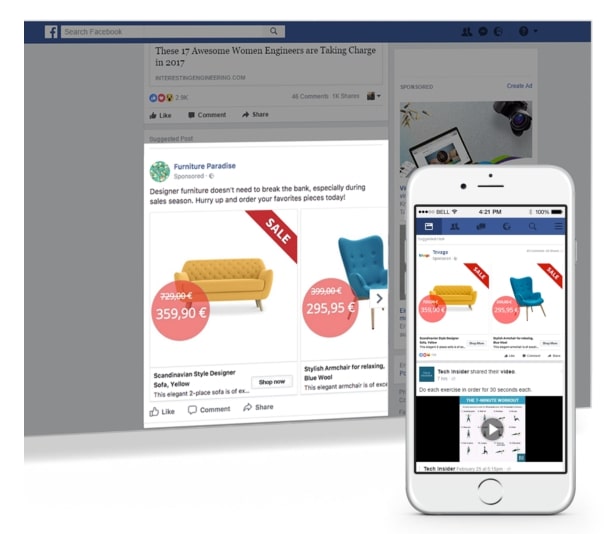
Facebook Dynamic Ads are a more specific, targeted ad format that automatically displays single or multi-product relevant ads to users who have already expressed interest in a product you are selling by visiting your website or app.
Facebook Dynamic ads use machine learning to track a user’s behavior, interest, and previous shopping experience to create a custom and highly personalized ad experience.
It also employs a dynamic template that draws information from your product catalog or feed, removing the burden of creating individual ads for every item you sell.
So, you can create a single catalog to list all your products and services and then set up one campaign to drive sales to your products using highly personalized recommendations and to offer information such as item availability, price, and special offers, all in the feed.
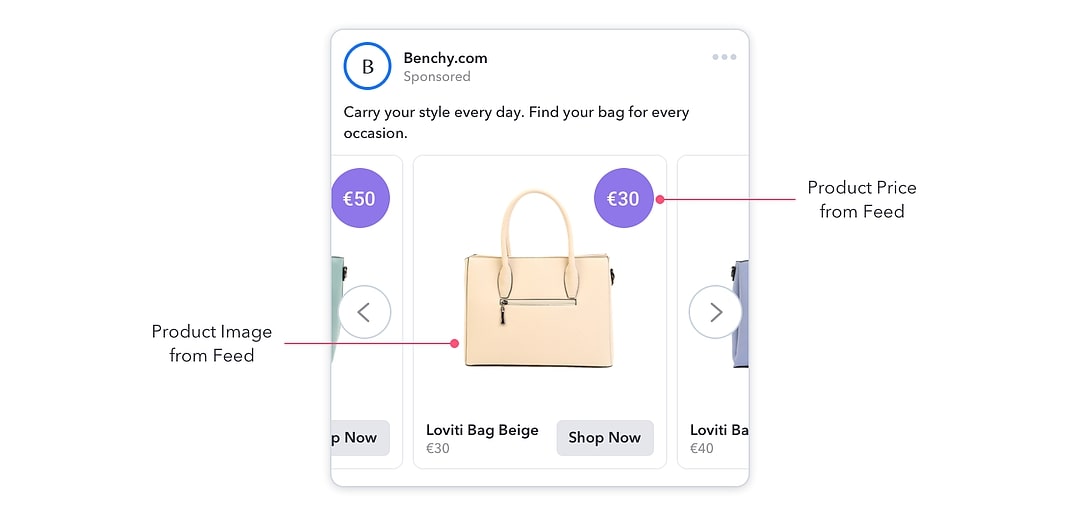
To a user, FB dynamic ads look something like this:

Dynamic Product Ads not only provide your campaigns with an added layer of personalization but save you time and effort by allowing you to serve highly relevant ads to your customers without manually creating different ads for all the products on your website.
Most popularly, dynamic ads appear in the News Feed. But that’s not the only placement.
They can appear as:
- in the Facebook News Feed
- in the right column of the feed on the desktop or within Instant Articles
- as short videos in in-stream videos
- in Marketplace
- within Messenger
- across the Audience Network
- and in Instagram
Facebook Dynamic ads offer two targeting options:
- For broad audiences – The ads will reach an audience who doesn’t know about your brand or didn’t visit your site, yet they have shown interest in similar products or services that you offer.
- For re-targeting consumers – These ads will reach people who have shown interest in any of your products on your website and made inquiries but left without purchasing. These ads are perfect for encouraging potential purchasers to be actual ones.
Below is an example of a Facebook Dynamic Product Ad re-targeting:
Dynamic Product Ads target three different customer behaviors:
- Viewed Content: After a customer views a product page on your store, you can serve them ads featuring the same product and encourage them to reconsider purchasing.
- Add to Cart: If a customer adds a product to their cart but doesn’t complete the purchase, you can show them ads to specifically promote that product, giving them a gentle reminder to finish the transaction.
Product Purchase: Once a customer successfully purchases a product, you can serve them ads featuring related products, upsells, new arrivals, and anything else that might be valuable to them based on their purchase history.
Dynamic Ads help e-commerce businesses to have control over the template and the product information displayed. It also offers Facebook targeting solutions that allow companies to target consumers with relevant and well-crafted ads.
Seeing the success of Facebook Dynamic Ads, other social media platforms like Snapchat and Pinterest have also launched their version of Dynamic Ads.
How Do Facebook Dynamic Product Ads Work?
Dynamic advertising sounds great, in theory. But how does it work?
It all starts with intelligent pieces of code–the Facebook pixel and the Facebook SDK.
The Facebook pixel code that is implemented on your website and the Facebook SDK code on your mobile app.
These codes allow you to track visitor actions on your digital platforms accurately. More importantly, they empower you to build and re-target audiences based on specific activities.
Once the codes are in place, you must upload a digital product catalog to the platform. The Facebook algorithm will then select and serve relevant products from this catalog, depending on the type of user.
Here’s a short scenario explaining how it works:
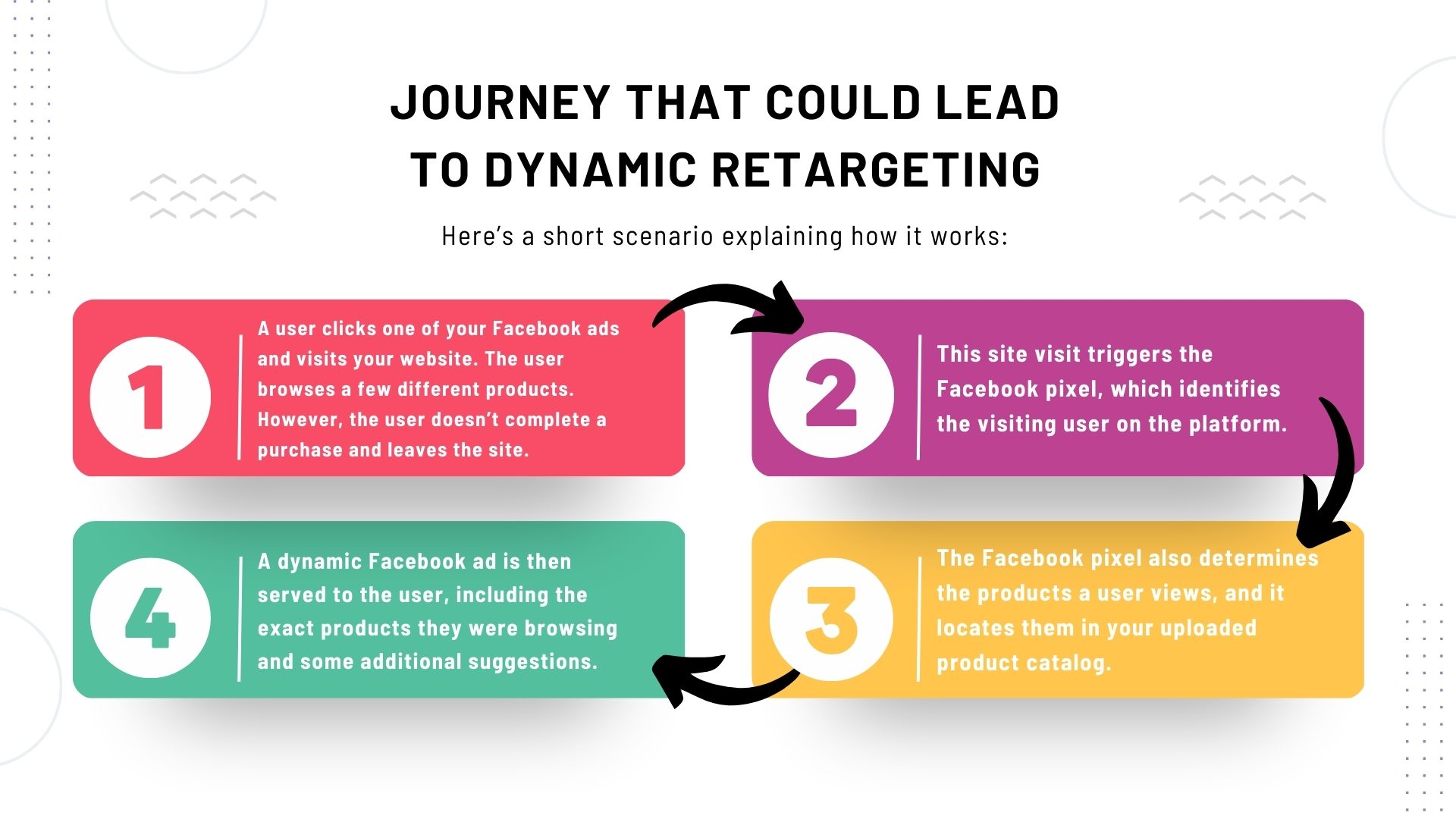
- A user clicks one of your Facebook ads and visits your website. The user browses a few different products. However, the user doesn’t complete a purchase and leaves the site.
- This site visit triggers the Facebook pixel, which identifies the visiting user on the platform.
- The Facebook pixel also determines the products a user views, and it locates them in your uploaded product catalog.
- A dynamic Facebook ad is then served to the user, including the exact products they were browsing and some additional suggestions.
Dynamic Product Ads track individual users’ behavior and use it to create custom ad experiences using products that they’ve previously viewed in your product catalog.
So, it automates your Facebook Remarketing efforts to handle the complex parts of setup and optimization for you.
Dynamic targeting can be utilized in several ways, but personalization is always the key.
The more targeted and relevant an ad feels for your audience, the more likely it is to generate a new conversion.
Benefits of Facebook Dynamic Ads
Highly Personalized Ad Content
Facebook dynamic Ads exhibit specific and relevant products and promotions to users who visit your website, making it easy to convert them to customers with a personalized shopping experience.
Exclude, Upsell, and Cross-sell Past Customers
Facebook dynamic Ads make it feasible to exclude people who have purchased your products already. It removes them from the ads and helps to save tons of money on ad spend.
Secondly, if you sell related products, you can cross-sell and up-sell to previous customers, helping to grow sales and lifetime values.
Cross-device Targeting
Dynamic Ads are optimized for cross-device targeting. It tracks website users on every device, such as desktop and mobile devices on Facebook, Instagram, Messenger, and other networks.
For instance, a visitor who browses your website on a desktop device and then revisits it on their mobile device can still see your ads on Facebook, Instagram, Messenger, and the Audience network.
Drives Targeted Social Traffic
The Product Ads drive social traffic to your product pages on your website, making it targeted traffic of users who are likely to make purchases rather than simply browsing.
Further Reading – Meta Business Suite aka. Facebook Business Manager Guide

Meta Business is a great tool for Businesses, and Juphy makes managing Meta Business Suite easier. Here are the reasons why! Read now!
How Can E-commerce Businesses Create and Set up Facebook Dynamic Ads?
To create a Facebook dynamic ad:
- Go to Ads Manager and click on Create “+”
- Create a campaign and choose your objective and select your catalog
- Create your ad set and select your product set
- Add images
- Select one out of the two:
- Add a card with a fixed image a the beginning
or
- Add a card at the end with your page profile picture
- Enter a headline and News Feed link description for your product set
- (Optional steps) Add a call to action button / Add a unique link to each item
That’s it! You have now successfully created a dynamic ad on Facebook.
Here are the five steps to set up a Facebook Dynamic Ad:
- Install Facebook Pixel or Facebook SDK
- Create a product catalog
- Create product sets
- Select your audience
- Create an ad
Best Practices for Maximizing E-commerce Sales with Facebook Dynamic Ads
Here are the ten best practices strategies to maximize your e-commerce sales and boost conversion rates at different stages of the sales funnel
1. Add Offers to Increase the Ad’s Appeal
You can reach high-intent audiences by giving an offer to your ad to push them over the edge to convert. Offers can vary depending on your business, but can include any of the below offers:
- A certain percentage off on the first purchase
- Free shipping
- A dollar amount of a purchase
- A free consultation or first-class
- A free sample or gift with the purchase

In the ad above, Cole Haan features an offer for 70% off, plus an extra 20% off using code EXTRA. They mention this in the ad copy and reinforce it in the image with a “Shop Now” CTA.
2. Include Multiple Text & Visual Options for Dynamic Formats
Users will see ad formats they’re most likely to interact with when using dynamic designs based on past on-platform activity that will take them to a relevant destination site.
When creating dynamic product ads, repurpose assets with tricks like “price” or “brand name” to apply applicable product catalog information to the standard copy you’ve created for these ads.
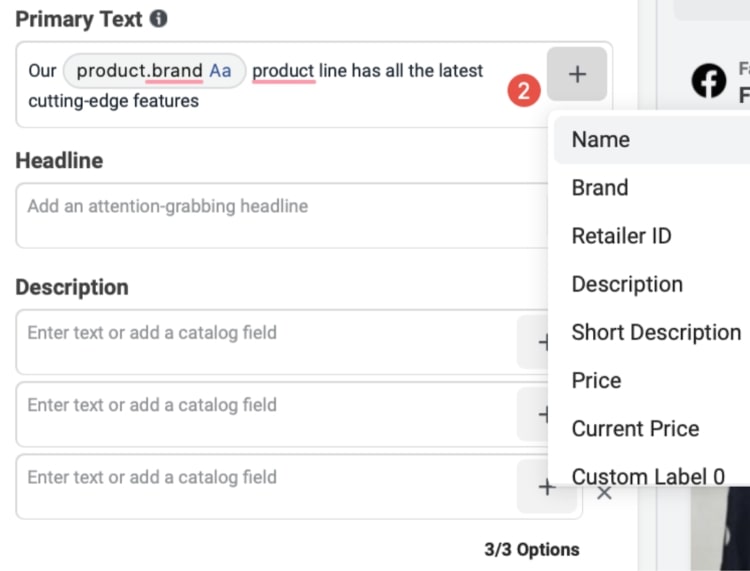
You can preview how this dynamic formatting will appear across multiple placements to ensure it works for your campaigns.
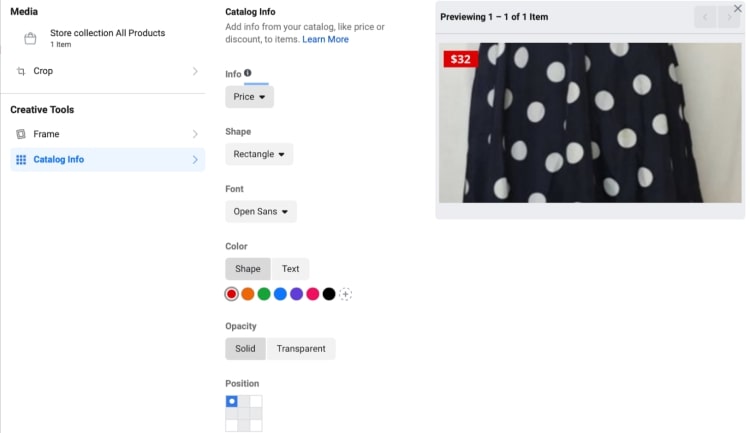
3. Localize Language & Pricing for International Ads
You must bring the language and pricing factor into the equation to expand your ad campaigns internationally. Someone in Germany may read your ad in English, but if they see a USD sign instead of a Euro, they will assume that the product isn’t available.
So, you must update your ad language and pricing based on the viewer’s geographical location. It is vital if you want to scale your campaign.
When creating your dynamic campaigns, you’ll get the option to add additional languages to your campaigns.
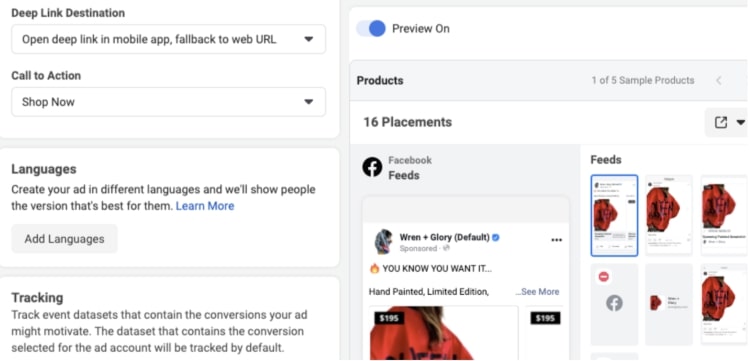
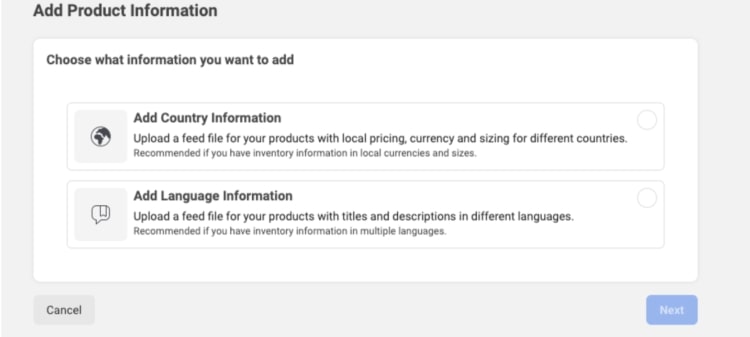
You can select “Add Languages” and then connect to different product feed files with product titles and descriptions in other languages. If applicable, you can also upload a feed file for your products containing local pricing, currency, and sizing for foreign countries.
While Facebook does have native translation features that users can rely on, it’s best to serve ads to users in their native language to avoid any auto-translation error. It also shows customers that you care about serving their specific market, which can help you gain trust and credibility.
4. Customize Static Creatives with Frames & Pricing Overlays
It’s a common tactic to add product pricing to a carousel description and an ad’s image. It can attract the user’s attention to the price point fast when they’re scrolling through the feed, which can, in turn, help increase conversions.
Unfortunately, adding prices to static images can be difficult at scale. Pricing often changes over time due to sale prices, special promotions, or standard changes in the market. Going back to edit every product image in your data feed is the last thing you want to do.
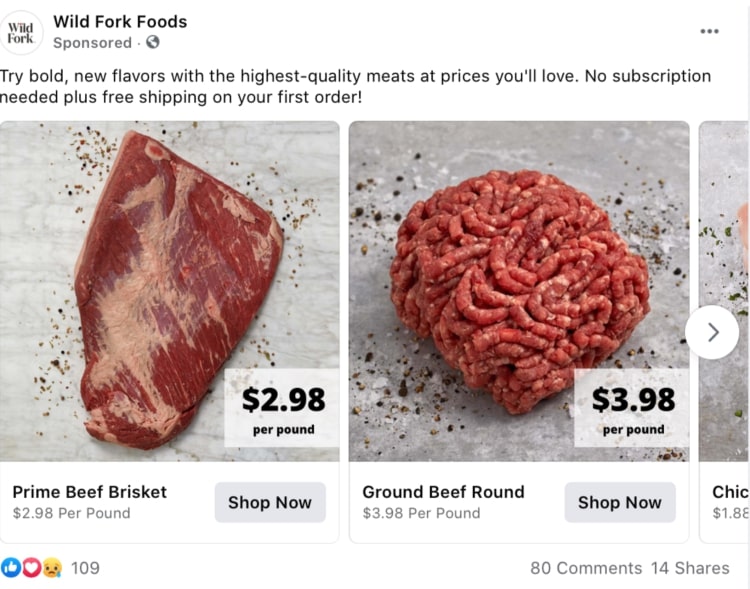
You can use frames and price overlays on Facebook to convert static images into dynamic ones with up-to-date real-time information.
You can include information regarding the price and free shipping feature on your images when running dynamic ads with the objectives of Leads, App Installs, or Catalog Sales.
Once done, you must select “Single Image or Video.” Then choose “Edit Creative” under “Creative Tools.” You can either add catalog information or a frame.

5. Choose Your First Carousel Image Wisely
If you’re using dynamic ads or carousel ads, the first visual is essential. as the users see it first. An appealing image can determine whether they want to interact with the ad.
While the default option is to let Facebook automatically allocate the product in the first card according to data, it has about what the person might be interested in. There is another way of approach.
You can select your image or video and exhibit unique content that portrays your brand before showcasing your products.
You can test both approaches and understand what’s best for you. But, be sure to choose a high-value visual to present your carousel, as it can help your campaign’s conversion rates to boost rapidly.
6. Test Image Slideshows
Facebook’s “slideshow” feature automatically pulls product images from your catalog to create a short video you can use in your dynamic ad creative. The slideshow feature can be used in carousel ads and single video ads. It can deliver high-quality videos effortlessly.
Slideshows allow you to put more products on display for the customers simultaneously. It also lets you showcase more images of a single item.
You can enable slideshows under the creative section of the ad creation process. It will pull images automatically from your product catalog to show multiple images per item.
7. Translate High-Performing Standalone Ads into Product Catalogs
Many brands test standalone ads to see which creatives and products perform best before they try dynamic product ads. You can use the information from early testing to take a high-performing standalone ad and turn it into a conceivable high-value product catalog.

8. Tracking Metrics and Measuring Success
Campaign metrics are one of the most important factors to consider when employing any marketing and advertising strategy, as they give you a clear picture of your campaign’s performance.
You can set appropriate goals before you begin your campaign to make it easier to track success.
Since the goal here is to boost sales, monitor the following metrics:
- Ad impressions show how many people are viewing your ads.
- CTR, or (Click-Through Rate), measures the number of people that click your ad link to visit the website.
- The bounce rate shows the retention capacity of your landing page. A high bounce rate means potential customers get to your website but leave without converting.
- Cost-per-click tracks how much you are charged when one of your ads is clicked by a visitor. This can give you an idea of how much revenue you get from each campaign.
- Conversion rate is a must-track metric as it gives you an overall idea of your ads’ performance.
The higher the conversion rate, the better your ads perform and the more money you make.
Track, measure, and adjust your key metrics appropriately until you get your desired results.
You also need to monitor and optimize your ads at regular intervals once it goes live to get the best results in terms of conversions. But be patient. Do not change or cancel an ad just because the results turned out differently than you wanted.
Instead, wait for the ad campaign to gather at least 1,000 impressions.
This gives the Facebook algorithm enough time to optimize and lets you make well-informed decisions.
What Are the Costs and Pricing Options for Facebook Dynamic Ads?
Facebook bills marketers on two primary metrics: CPC, or the cost per click, and CPM, or the cost per mile, also known as cost per thousand impressions. Research indicates that advertisers may pay $12.07 per 1,000 impressions or $0.94 per click.
Average CPC for Facebook Ads
The CPC on Facebook, on average, is $0.94, making it cheaper than other advertising platforms like LinkedIn, Instagram, or YouTube.
Seasonality and competition influence the cost of a winning Facebook ad auction bid—especially when a website visit is the preferred outcome for most advertisers. Running campaigns in the first half of the year is wise as it is cheaper.
Average CPM for Facebook Ads
Facebook boasts 2.8 billion monthly active users, so eCommerce stores use this platform to create brand awareness. Many users use Facebook to engage with their favorite brands.
To increase awareness and reach through Facebook ads, expect to pay $12.07 to get 1,000 people.
Average Cost Per Lead (CPL)
Apart from the two metrics that determine how advertisers pay for Facebook ads, other financial metrics like CPL come into play to understand the cost of your ad campaigns.
The average cost per lead is $5.83, according to research. But if you can get your audience targeting right, this could be cut dramatically.
Manage Facebook Dynamic Ad Comments with Juphy!
Personalization is at the core of any dynamic ad, making these ads so efficient in driving sales and user acquisition.
When users see a highly personalized, dynamic ad, they will want to comment on it. One of the most common issues e-commerce businesses face with dynamic ads is the inability to manage user engagement.
If your comment section is filled with negative and spam comments, it can be a huge bummer that can push away potential customers and affect ad performance and your brand’s online reputation.
If these comments go unnoticed throughout the campaigns and brands do not address them promptly, it amplifies the negative effect on the brand and the ad campaigns.
Brands should be able to manage the incoming comments well to deliver a great customer experience with an all-in-one social media management platform, like Juphy.
With Juphy’s social inbox, all your dynamic ad comments effortlessly merge into a unified inbox. It pulls all the incoming messages and comments, even from the unlisted or “dark post” ads on Facebook, which saves valuable time and positively impacts result rates.
Juphy ad comment moderation helps brands manage comment activity. They can easily delete and hide Facebook ad comments and even set up automation rules to tag the comments, with specified keywords, under a specific category.
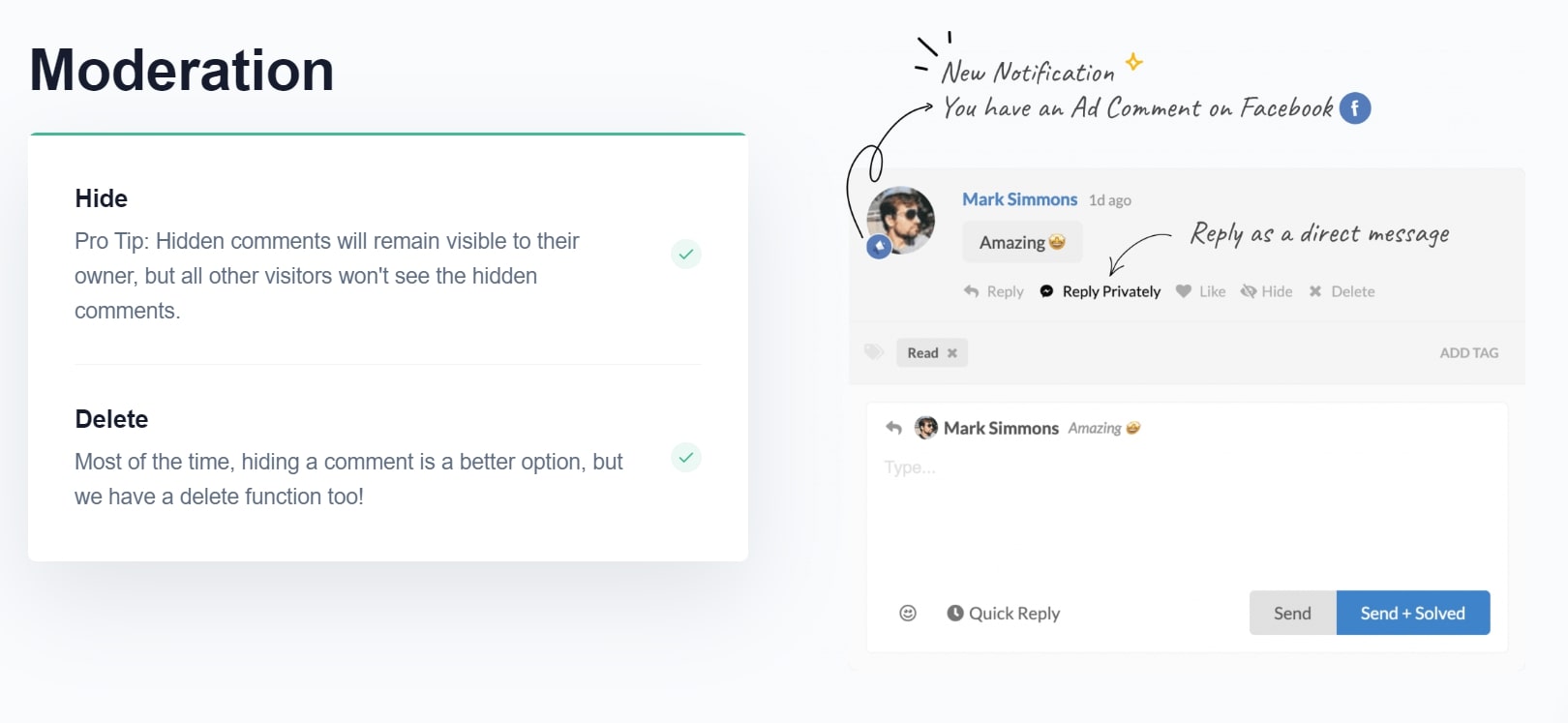
Cleaning up and removing hateful, spammy, or off-topic comments helps the brand to create a better experience for people viewing the ad significantly improves brand sentiment, and gives good e-commerce conversion rates.
Automation rules help you to prioritize messages and comments according to content, urgency, and tone. You can also assign conversations and messages to your team members through team collaboration and reply in a streamlined manner with a consistent brand voice.
You can reply to a comment, send a direct message, or like a comment on the ad to boost engagement.
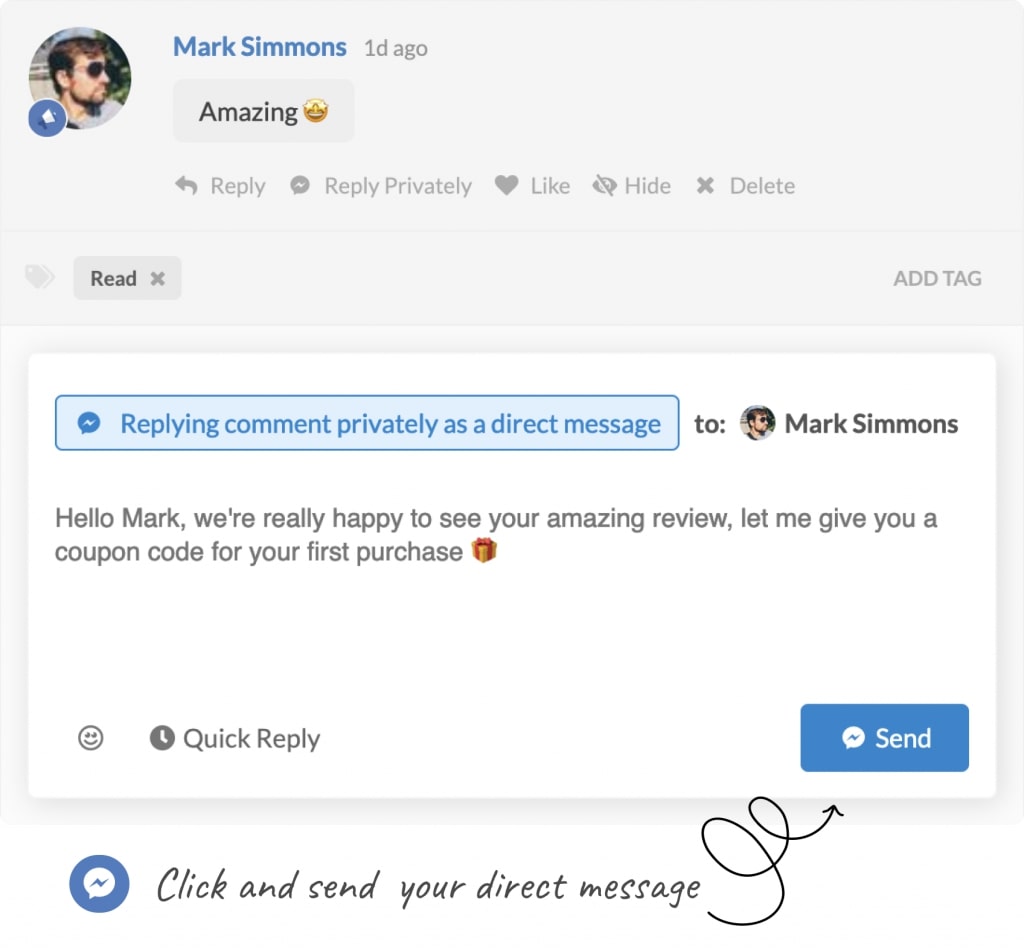
Identifying comments that contain glowing reviews or feedback about your product or brand is also crucial in driving results from your dynamic ads campaign.
Canned response features help customer support agents reply to recurring inquiries, reducing the daily volumes of comments requiring attention and escalating the most urgent ones for you to handle.
Arm with the power of Hyper-targeted Facebook dynamic ad campaigns that resonate with your audience and achieve unprecedented success along with Juphy to manage your incoming ad comments effortlessly and manage social media for e-commerce effectively and deliver an elevated level of customer experience.
You can start your 7-day free trial without any credit card information or book a live online demo with Juphy today!
FAQ
Facebook Dynamic Ads are a more specific, targeted ad format that automatically displays single or multi-product relevant ads to users who have already expressed interest in a product you are selling by visiting your website or app.
Facebook Dynamic ads use machine learning to track a user’s behavior, interest, and previous shopping experience to create a custom and highly personalized ad experience.
It also employs a dynamic template that draws information from your product catalog or feed, removing the burden of creating individual ads for every item you sell.
So, you can create a single catalog to list all your products and services and then set up one campaign to drive sales to your products using highly personalized recommendations and offering information such as item availability, price, and special offers, all in the feed.
For broad audiences – The ads will reach an audience who doesn’t know about your brand or didn’t visit your site, yet they have shown interest in similar products or services that you offer.
For re-targeting consumers – These ads will reach people who have shown interest in any of your products on your website, and made inquiries but left without purchasing. These ads are perfect for encouraging potential purchasers to be actual ones.
It all starts with intelligent pieces of code–the Facebook pixel and the Facebook SDK.
The Facebook pixel code that is implemented on your website and the Facebook SDK code on your mobile app.
These codes allow you to track visitor actions on your digital platforms accurately. More importantly, they empower you to build and re-target audiences based on specific actions.
Highly personalized ad content
Exclude, up-sell, and cross-sell past customers
Cross-device targeting
Drives targeted social traffic
1. Go to Ads Manager and click on Create “+”
2. Create a campaign and choose your objective and select your catalog
3. Create your ad set and select your product set
4. Add images
5. Select one out of the two:
Add a card with a fixed image a the beginning or add a card at the end with your page profile picture
6. Enter a headline and News Feed link description for your product set
7. (Optional steps) Add a call to action button / Add a unique link to each item
Related Article – 5 Ways to Fix Facebook Comments Not Showing

Are Facebook comments not showing? That is a nerve-racking problem. Find out five ways to fix this issue with Juphy. Read more now!
